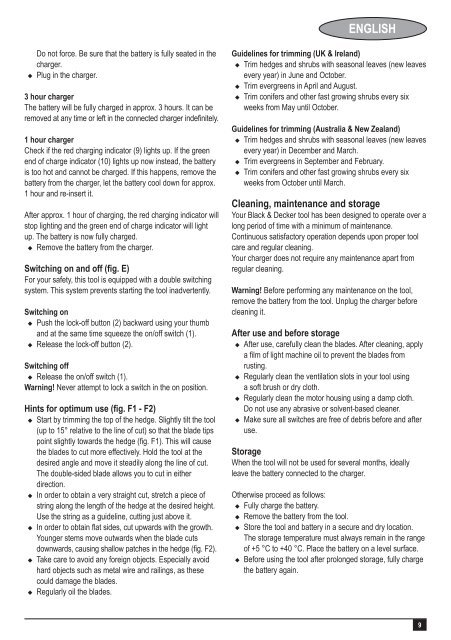BlackandDecker Taille Haies Sans Fil- Gtc800nm - Type H1 - Instruction Manual (Européen)
BlackandDecker Taille Haies Sans Fil- Gtc800nm - Type H1 - Instruction Manual (Européen)
BlackandDecker Taille Haies Sans Fil- Gtc800nm - Type H1 - Instruction Manual (Européen)
You also want an ePaper? Increase the reach of your titles
YUMPU automatically turns print PDFs into web optimized ePapers that Google loves.
ENGLISH<br />
Do not force. Be sure that the battery is fully seated in the<br />
charger.<br />
u Plug in the charger.<br />
3 hour charger<br />
The battery will be fully charged in approx. 3 hours. It can be<br />
removed at any time or left in the connected charger indefinitely.<br />
1 hour charger<br />
Check if the red charging indicator (9) lights up. If the gre<strong>en</strong><br />
<strong>en</strong>d of charge indicator (10) lights up now instead, the battery<br />
is too hot and cannot be charged. If this happ<strong>en</strong>s, remove the<br />
battery from the charger, let the battery cool down for approx.<br />
1 hour and re-insert it.<br />
After approx. 1 hour of charging, the red charging indicator will<br />
stop lighting and the gre<strong>en</strong> <strong>en</strong>d of charge indicator will light<br />
up. The battery is now fully charged.<br />
u Remove the battery from the charger.<br />
Switching on and off (fig. E)<br />
For your safety, this tool is equipped with a double switching<br />
system. This system prev<strong>en</strong>ts starting the tool inadvert<strong>en</strong>tly.<br />
Switching on<br />
u Push the lock-off button (2) backward using your thumb<br />
and at the same time squeeze the on/off switch (1).<br />
u Release the lock-off button (2).<br />
Switching off<br />
u Release the on/off switch (1).<br />
Warning! Never attempt to lock a switch in the on position.<br />
Hints for optimum use (fig. F1 - F2)<br />
u Start by trimming the top of the hedge. Slightly tilt the tool<br />
(up to 15° relative to the line of cut) so that the blade tips<br />
point slightly towards the hedge (fig. F1). This will cause<br />
the blades to cut more effectively. Hold the tool at the<br />
desired angle and move it steadily along the line of cut.<br />
The double-sided blade allows you to cut in either<br />
direction.<br />
u In order to obtain a very straight cut, stretch a piece of<br />
string along the l<strong>en</strong>gth of the hedge at the desired height.<br />
Use the string as a guideline, cutting just above it.<br />
u In order to obtain flat sides, cut upwards with the growth.<br />
Younger stems move outwards wh<strong>en</strong> the blade cuts<br />
downwards, causing shallow patches in the hedge (fig. F2).<br />
u Take care to avoid any foreign objects. Especially avoid<br />
hard objects such as metal wire and railings, as these<br />
could damage the blades.<br />
u Regularly oil the blades.<br />
Guidelines for trimming (UK & Ireland)<br />
u Trim hedges and shrubs with seasonal leaves (new leaves<br />
every year) in June and October.<br />
u Trim evergre<strong>en</strong>s in April and August.<br />
u Trim conifers and other fast growing shrubs every six<br />
weeks from May until October.<br />
Guidelines for trimming (Australia & New Zealand)<br />
u Trim hedges and shrubs with seasonal leaves (new leaves<br />
every year) in December and March.<br />
u Trim evergre<strong>en</strong>s in September and February.<br />
u Trim conifers and other fast growing shrubs every six<br />
weeks from October until March.<br />
Cleaning, maint<strong>en</strong>ance and storage<br />
Your Black & Decker tool has be<strong>en</strong> designed to operate over a<br />
long period of time with a minimum of maint<strong>en</strong>ance.<br />
Continuous satisfactory operation dep<strong>en</strong>ds upon proper tool<br />
care and regular cleaning.<br />
Your charger does not require any maint<strong>en</strong>ance apart from<br />
regular cleaning.<br />
Warning! Before performing any maint<strong>en</strong>ance on the tool,<br />
remove the battery from the tool. Unplug the charger before<br />
cleaning it.<br />
After use and before storage<br />
u After use, carefully clean the blades. After cleaning, apply<br />
a film of light machine oil to prev<strong>en</strong>t the blades from<br />
rusting.<br />
u Regularly clean the v<strong>en</strong>tilation slots in your tool using<br />
a soft brush or dry cloth.<br />
u Regularly clean the motor housing using a damp cloth.<br />
Do not use any abrasive or solv<strong>en</strong>t-based cleaner.<br />
u Make sure all switches are free of debris before and after<br />
use.<br />
Storage<br />
Wh<strong>en</strong> the tool will not be used for several months, ideally<br />
leave the battery connected to the charger.<br />
Otherwise proceed as follows:<br />
u Fully charge the battery.<br />
u Remove the battery from the tool.<br />
u Store the tool and battery in a secure and dry location.<br />
The storage temperature must always remain in the range<br />
of +5 °C to +40 °C. Place the battery on a level surface.<br />
u Before using the tool after prolonged storage, fully charge<br />
the battery again.<br />
9
















